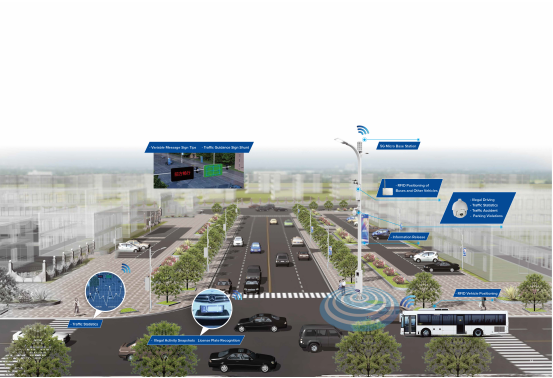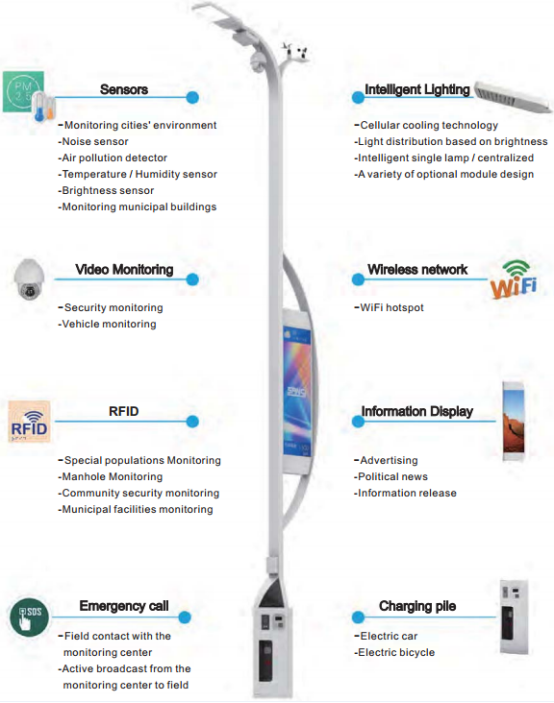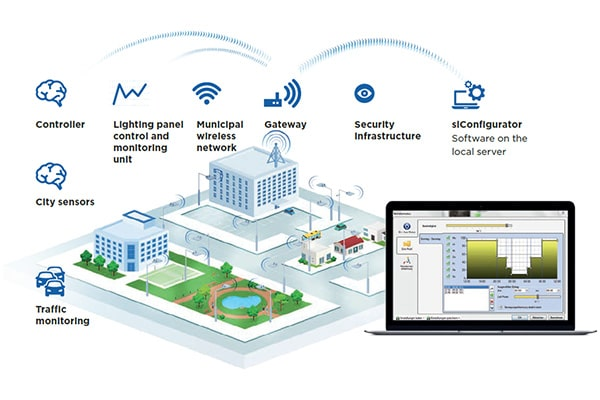
Smart street lights are network-connected street lighting systems that incorporate outdoor light controllers, IoT devices, and sensors. These intelligent street lights have the ability to automatically adjust their light intensity based on various factors, such as sunset and sunrise times, daily schedules, human presence, traffic flow, and weather conditions. This advanced functionality enables significant energy savings and reduces maintenance costs.
Being A Carrier for 5G Communication - End-to-end Nodes of Smart Network
Due to the advantages of wide coverage and uniform distribution of smart street lights, more and more urban construction organizations make them as the carrier of their 5G base stations of rapid development of communication technology. Sansi LED’s smart street light integrates infrastructure and IoT components together to realize the unified applications, saving energy, improving security, lowering pollution, and innovating modern city life.
The primary objective of smart street lighting is to enhance the illumination of roadways, sidewalks, and parking spaces to ensure public safety. To achieve specific brightness, illuminance, darkness, uniformity, and glare values, smart lighting systems utilize appropriate technologies such as LED or HID lamps. HID lamps are still widely used globally for illuminating large areas.
Although HID lamps are cheaper to install and replace compared to LED lamps, they are gradually being replaced by LEDs due to their energy inefficiency. HID lamps require a 20-second warm-up period before reaching full power, emit up to 70% less visible light after 50,000 hours of use, and waste about 30% of their energy in the infrared spectrum. Conversely, LED lamps have an extremely long lifetime of over 500,000 hours, can reduce energy costs by up to 60%, have no warm-up period, and offer a payback period of 6 to 18 months.
A smart street light pole is an advanced lighting infrastructure designed to incorporate various technological features beyond simple illumination. These poles serve as multifunctional platforms for integrating smart city technologies and improving urban efficiency, safety, and sustainability. Light poles have been used for centuries to support street lighting sources and have evolved alongside lighting technology. Today, they are also utilized for supporting traffic signals or communication infrastructure. Technological advancements have facilitated the integration of sensors and IoT devices onto street lighting poles, thereby fostering the development of smart cities. The street lighting grid remains powered at all times, including during the day, enabling individual control of lamps and the installation of sensors and actuators for smart city synergies.


Smart street light poles are equipped with intelligent lighting controls that allow for dynamic adjustment of brightness levels, timing schedules, and light distribution patterns. These controls can be programmed based on factors such as time of day, traffic conditions, pedestrian activity, and weather conditions, optimizing energy usage and enhancing visibility as needed.
Segment-level control involves a group of up to 200 streetlights that communicate with the power cabinet for automated on/off control. Feeder posts receive and manage data from the lights, which is then transmitted to a secure server for storage and display on a dashboard. On the other hand, individual lamp control is managed through a fixture controller, allowing for on/off/dimming control or adaptive lighting. The controller can also provide feedback on electrical parameters, real-time fault reporting, and optional sensors for measuring light, motion, temperature, humidity, noise, and more.
By implementing lamp-level control, the lighting grid can remain energized during the day, enabling the installation of other smart city applications like sensors, controllers, CCTV cameras, or communication devices. The main standards for luminaire control include 0-10, DALI1, and DALI2. It is crucial to ensure compatibility between the intelligent lighting controller and the luminaire control system. Additionally, additional sensors can be integrated into the system to deploy special lighting control features or install unrelated sensors. An example of this is adaptive lighting, which requires the integration of a motion sensor on the light pole, typically connected directly to the lighting controller. Smart street light poles represent a key component of modern urban infrastructure, offering enhanced functionality, efficiency, and sustainability compared to traditional street lighting systems. They play a crucial role in the development of smart cities and the advancement of urban innovation.
Sansi LED’s smart street light is equipped with a range of advanced functions, including real-time information broadcasting, environmental condition display, one-button emergency call, wireless WiFi, and electric vehicle charging stations. Additionally, the LED screens produced by Sansi LED are allowing community authorities to deliver real-time information to the residents.
Illuminate every important moment of your life, and make it memorable and fantastic!
Contact us at sales@sansitech.us & b2b.marketing@sansitech.us.